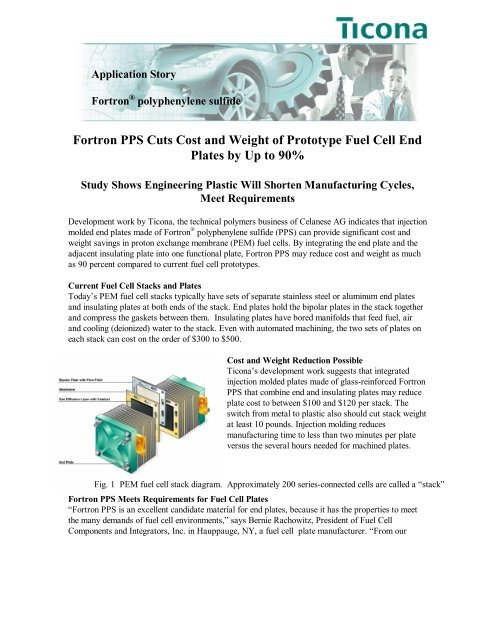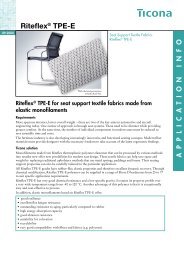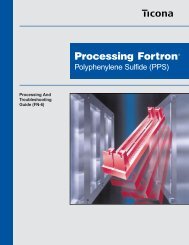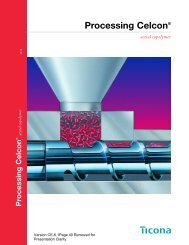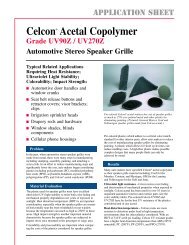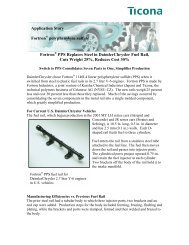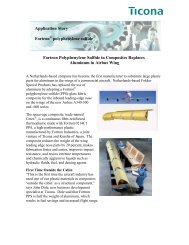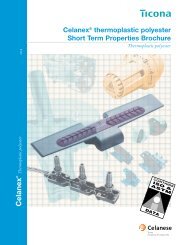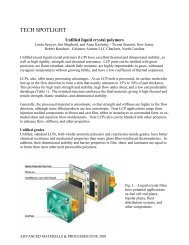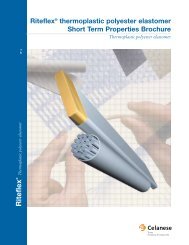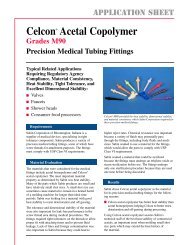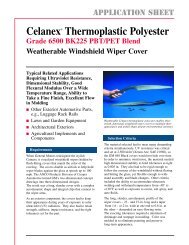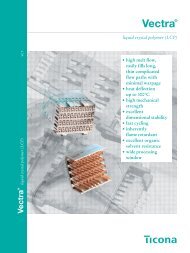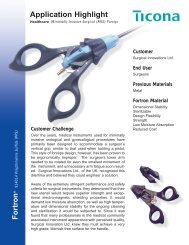Fortron PPS Cuts Cost and Weight of Prototype Fuel ... - Hi Polymers
Fortron PPS Cuts Cost and Weight of Prototype Fuel ... - Hi Polymers
Fortron PPS Cuts Cost and Weight of Prototype Fuel ... - Hi Polymers
You also want an ePaper? Increase the reach of your titles
YUMPU automatically turns print PDFs into web optimized ePapers that Google loves.
Application Story<strong>Fortron</strong> ® polyphenylene sulfide<strong>Fortron</strong> <strong>PPS</strong> <strong>Cuts</strong> <strong>Cost</strong> <strong>and</strong> <strong>Weight</strong> <strong>of</strong> <strong>Prototype</strong> <strong>Fuel</strong> Cell EndPlates by Up to 90%Study Shows Engineering Plastic Will Shorten Manufacturing Cycles,Meet RequirementsDevelopment work by Ticona, the technical polymers business <strong>of</strong> Celanese AG indicates that injectionmolded end plates made <strong>of</strong> <strong>Fortron</strong> ® polyphenylene sulfide (<strong>PPS</strong>) can provide significant cost <strong>and</strong>weight savings in proton exchange membrane (PEM) fuel cells. By integrating the end plate <strong>and</strong> theadjacent insulating plate into one functional plate, <strong>Fortron</strong> <strong>PPS</strong> may reduce cost <strong>and</strong> weight as muchas 90 percent compared to current fuel cell prototypes.Current <strong>Fuel</strong> Cell Stacks <strong>and</strong> PlatesToday’s PEM fuel cell stacks typically have sets <strong>of</strong> separate stainless steel or aluminum end plates<strong>and</strong> insulating plates at both ends <strong>of</strong> the stack. End plates hold the bipolar plates in the stack together<strong>and</strong> compress the gaskets between them. Insulating plates have bored manifolds that feed fuel, air<strong>and</strong> cooling (deionized) water to the stack. Even with automated machining, the two sets <strong>of</strong> plates oneach stack can cost on the order <strong>of</strong> $300 to $500.<strong>Cost</strong> <strong>and</strong> <strong>Weight</strong> Reduction PossibleTicona’s development work suggests that integratedinjection molded plates made <strong>of</strong> glass-reinforced <strong>Fortron</strong><strong>PPS</strong> that combine end <strong>and</strong> insulating plates may reduceplate cost to between $100 <strong>and</strong> $120 per stack. Theswitch from metal to plastic also should cut stack weightat least 10 pounds. Injection molding reducesmanufacturing time to less than two minutes per plateversus the several hours needed for machined plates.Fig. 1 PEM fuel cell stack diagram. Approximately 200 series-connected cells are called a “stack”<strong>Fortron</strong> <strong>PPS</strong> Meets Requirements for <strong>Fuel</strong> Cell Plates“<strong>Fortron</strong> <strong>PPS</strong> is an excellent c<strong>and</strong>idate material for end plates, because it has the properties to meetthe many dem<strong>and</strong>s <strong>of</strong> fuel cell environments,” says Bernie Rachowitz, President <strong>of</strong> <strong>Fuel</strong> CellComponents <strong>and</strong> Integrators, Inc. in Hauppauge, NY, a fuel cell plate manufacturer. “From our
experience, it molds well, replicates fine features <strong>and</strong> has little warpage compared to other plasticswe’ve evaluated. In use, it is stiff, strong <strong>and</strong> hard, has low creep, <strong>and</strong> looks <strong>and</strong> feels like metal.”Ami M. El Agizy, Ticona’s market development manager for fuel cells, says <strong>Fortron</strong> <strong>PPS</strong> has thepurity needed to satisfy known electrochemical dem<strong>and</strong>s in fuel cells. Tests show this material haslittle effect on the conductivity <strong>of</strong> the fluids in contact with it. <strong>Fortron</strong> <strong>PPS</strong> grade 1140L4 generatesonly a 2 µS/cm change in conductivity in a 50 percent glycol solution after seven days (See Figure 2).Maintaining low conductivity in the end-plates <strong>and</strong> minimizing ionic impurities which might leach intothe electrolyte are key to continued fuel stack efficiency.
“<strong>Fortron</strong> <strong>PPS</strong> has excellent dimensional stability <strong>and</strong> retains its mechanical properties attemperatures <strong>of</strong> over 200°C,” says El Agizy. “This is well above the 80°C at which PEM fuel cellsnow operate <strong>and</strong> the 150°C projected for the next PEM generation. “It also has the rigidity needed totolerate the high stresses that go along with compressing PEM fuel stacks, as well as long-termresistance to deionized water, oxygen, <strong>and</strong> propane, natural gas <strong>and</strong> other hydrocarbon fuels. Beyondthis, the <strong>PPS</strong> is a good insulator, has a low coefficient <strong>of</strong> thermal expansion, absorbs little water <strong>and</strong>is inherently flame retardant.”<strong>Fortron</strong> ® <strong>PPS</strong> <strong>and</strong> Celstran ® <strong>PPS</strong>-GF for <strong>Fuel</strong> Cell PlatesTicona <strong>of</strong>fers both short <strong>and</strong> long glass fiber-reinforced <strong>PPS</strong> grades. Smaller fuel cell stacks placerelatively low stress on the end plates, <strong>and</strong> short fiber-reinforced <strong>Fortron</strong> 1140L4 <strong>PPS</strong> is useful forthese applications. Larger stacks may require Celstran ® <strong>PPS</strong>-GF, which contains long glass fiberschemically coupled to the plastic matrix using a patented pultrusion process that fully impregnatesthem. The fully wetted fibers greatly improve the polymer’s mechanical properties.As part <strong>of</strong> its fuel cell activities, Ticona/Celanese is a member <strong>of</strong> the U.S. <strong>Fuel</strong> Cell Council(USFCC), an industry association dedicated to fostering the commercialization <strong>of</strong> fuel cells in theUnited States. The association’s website may be accessed at www.usfcc.com.More Information AvailableA description <strong>of</strong> fuels cells, how they operate, some typical applications, membrane electrodeassemblies (MEAs), <strong>and</strong> animated graphics, is presented online.Information about engineering thermoplastics for fuel cell applications, with downloadable graphics,is available online.Datasheets <strong>Fortron</strong> <strong>PPS</strong> Celstran LFRT1140L4 (40% Glass Fiber) GF50-01 50% long glass fiber reinforcementGF40-01 40% long glass fiber reinforcementGF30-01 30% long glass fiber reinforcementTechnical Information: 1-800-833-4882 Customer Services: 1-800-526-4960NOTICE TO USERS: To the best <strong>of</strong> our knowledge, the information contained in this publication is accurate; however, we do not assume anyliability whatsoever for the accuracy <strong>and</strong> completeness <strong>of</strong> such information. The information contained in this publication should not be construed as a promise orguarantee <strong>of</strong> specific properties <strong>of</strong> our products.Any values shown are based on testing <strong>of</strong> laboratory test specimens <strong>and</strong> represent data that fall within the st<strong>and</strong>ard range <strong>of</strong> properties for natural material. Thesevalues alone do not represent a sufficient basis for any part design. Colorants or other additives may cause significant variations in data values.Properties <strong>of</strong> molded parts can be influenced by a wide variety <strong>of</strong> factors including, but not limited to, material selection, additives, part design, processingconditions <strong>and</strong> environmental exposure. Any determination <strong>of</strong> the suitability <strong>of</strong> a particular material <strong>and</strong> part design for any use contemplated by the users <strong>and</strong> themanner <strong>of</strong> such use is the sole responsibility <strong>of</strong> the users, who must assure themselves that the material as subsequently processed meets the needs <strong>of</strong> theirparticular product or use.It is the sole responsibility <strong>of</strong> the users to investigate whether any existing patents are infringed by the use <strong>of</strong> the materials mentioned in this publication.Please call the numbers listed for additional technical information. Call Customer Services for the appropriate Materials Safety Data Sheets (MSDS) beforeattempting to process our products.The products mentioned herein are not intended for use in medical or dental implants.Ticona LLCTicona GmbH90 Morris Avenue Pr<strong>of</strong>essor Staudinger Str.Summit, NJ USA 07901 65451 Kelstelbach, Germanywww.ticona.com02-326/Elec/0502


